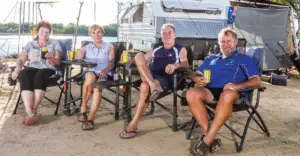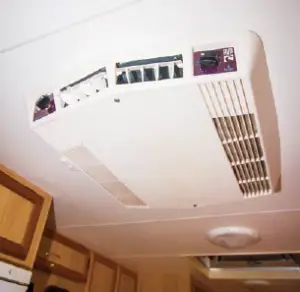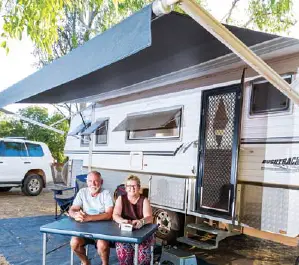COOLER FREE CAMPS
Avoid extreme Australian temperatures while free camping with these expert tips on the best ways to stay cool
WORDS BY TRAVIS ANNABEL PHOTOGRAPHY BY CARAVAN AND MOTORHOME

Australia is a country of extremes, and during summer temperatures, some parts of the country can get as high as 50°C. The thing is, extreme temperatures are part and parcel of experiencing Australia, and staying cool while you’re free camping can be a real challenge. Keeping cool while you’re off the grid should be a priority, but is it possible to do it cheaply and efficiently, while ensuring you have enough power left over to keep the fridge and TV running?
We reckon it is, and to prove it, here are our best expert tips for staying cool while you’re off the grid! We’ve also spoken to Gary Moreland, a regular contributor who has experienced free camping in extreme conditions himself and has provided his hard-learnt tips.
AIR CONDITIONING
Air conditioning is the most obvious way to stay cool – but are you getting the most from yours?
THE RIGHT AIR CON FOR YOUR NEEDS
If you don’t do your research and ensure you’re getting the right air con for your needs, then you’ve spent a lot of money on something that may not get the job done. Here’s a few things to consider:
ROOF MOUNTED VS UNDER BUNK UNITS
Which unit suits your needs best? If efficiency and a lack of storage space is an issue and you’re looking at a competitively priced option, then a roof mounted air con could be the best choice. They are more efficient at drawing out hot air and don’t take up any storage space, and because there are so many models and brands available pricing is highly competitive.
If you own a pop-top RV or if your van’s clearance height or weight distribution is something you need to consider, then an under-bunk ducted system could be better suited to your needs.
SIZE MATTERS
Most air con units are supplied with information on their approximate capability, so it’s important to ensure you don’t try to stretch the unit’s capability. For example, if a unit says it’s suitable for vans up to six metres in length, then don’t try to stretch that to a larger van of seven or more metres, as you’ll be disappointed in its performance. As a general rule of thumb, 2kW to 2.5kW units are suitable for vans up to five metres, while units over 3kW will be suitable for vans up to seven metres in length.
VAN DESIGN FACTORS
Is your van insulated? Does it have large windows or windows without curtains? These are factors that could severely impact the efficiency and capability of your air con. Simply put, if your van has large windows or its panelling isn’t insulated, looking at installing a higher capacity unit is a smart idea. Most air con manufacturers will assume your van is insulated, so if yours isn’t then ensure you mention it to the manufacturer or supplier and they’ll be able to suggest a capacity that will counter the lack of insulation.

USING YOUR AIR CON EFFICIENTLY
What you need to know to ensure your air con runs efficiently and enable you to stay at that stunning free camp for as long as possible
1 TEMPERATURE SELECTION
Don’t try to force the unit to do its job quicker, because it won’t work. If your van is 30°C inside, setting the AC to 16°C won’t make it cool any quicker than having it set to 21°C. So set it to the temperature you want, and let it go. Additionally, avoid turning it on and off unnecessarily.
2 HELP THE AIR CON HELP YOU
When possible, try to setup camp in the shade, and ensure you keep all of the blinds and curtains closed while you’re away from camp to avoid heat building up unnecessarily. Also, while the air con is running, ensure you keep all your windows and doors closed.
3 REGULAR SERVICING
Firstly, ensure you keep the filters clean by checking them regularly. Also, make sure you regularly check the external grills for debris that may block them such as leaves, as this will greatly affect the unit’s performance. Cleaning the unit’s condenser grill fins once a year with condensed air will ensure efficient performance, as will ensuring all the electrical plugs and connectors are free of corrosion.
ALTERNATIVE WAYS TO KEEP COOL
For those who want to maximise the time they can spend off the grid, here’s a look at the best ways to stay cool without relying on your air con
3 TIPS FOR SITE SELECTION
1 USING SHADE SENSIBLY
“In hotter climates the highest temperatures often occur in the afternoons. Selecting a site with afternoon shade will still allow solar panels to work during peak sunshine period for a large portion of the day.” – Gary Moreland
2 FLOWING WATER
“There seems to be something about flowing water that is cooling for the soul. Sitting dangling legs in the river, swimming (if suitable) or merely paddling in the water before sitting down to a cold drink all help to lessen the impact of a hot day.” – Gary Moreland
3 VAN ORIENTATION
When possible, try and position your van facing east-west. This ensures sun shines on the top of the van and the lower profile front and rear panels instead of on the larger area sides.
KEEPING OUT OF THE SUN
USE YOUR AWNING
Obviously an awning will offer shade for you to sit under, but did you realise that it will also help prevent the sun from hitting the side of your van and generating additional internal heat? Also, if you invest in awning walls or shade mesh privacy walls, then you’re providing additional shade and protection from the sun while allowing the breeze to still come through.
CHASE THE SHADE
“We chase the shade around the van. If there is sun streaming in under the awning side, pick up your seats and enjoy the deep shade on the other side of the van. When free camping, there are often trees nearby and there is nothing as good as finding a cool shady spot to sit on a chair under a tree.” – Gary Moreland

OTHER GEAR TO KEEP YOU COOL
1 12V PORTABLE FAN
“We have an excellent portable oscillating multi-speed fan that we use to circulate air in the van on those stuffy nights when there is no breeze. The portable unit contains its own battery which is rechargeable from 12V DC as well as via a 240V adapter.” – Gary Moreland
2 FIXED FANS
A more permanent solution is to install a fixed fan in your van that’s powered off the van’s batteries. This can be a more power-efficient method, and can also help your van’s air con perform more efficiently by circulating the air better.
3 EVAPORATIVE COOLERS
“There are a number of smart products around that act as evaporative coolers, some that even include space to put ice-blocks in the water tank. These coolers do work, but similar to house evaporative coolers, rely upon flow of air through the area. This is best achieved by leaving some windows or the caravan door open to allow breeze to flow through the van. Personally in our case we have always found the fan sufficient.” – Gary Moreland
ENSURING YOU HAVE ENOUGH POWER
If there’s one thing that Australia’s hottest regions usually have in abundance, it’s sunlight. Of course using the sun to power as many of your cooling devices is the best and most efficient way to ensure that you remain as cool as possible while free camping, so it’s hugely important to ensure that when you setup your 12V and solar system, you’re anticipating everything that could be running off it and you build your system so it can easily handle it.
That being said, it’s important to ensure you have a solid backup, and a generator is your best bet. The trick here is to ensure you only rely on your generator when you absolutely have to – that way, you’re minimising the cost involved in running it.
Also, running your fridges off gas can take some of the pressure off your 12V system if you find it struggling to keep everything running and your van cool, but again this is not a free power option like solar, so use it sparingly.

